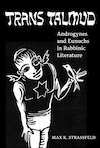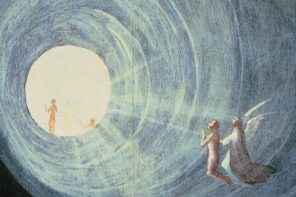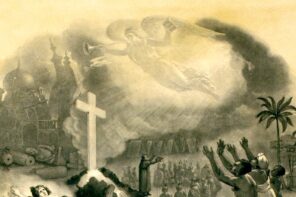To many, last month’s brutal attack on a queer nightclub in Colorado Springs, in which five people were killed and 25 were injured, was the logical conclusion of the Right’s increasingly dehumanizing rhetoric against the LGBTQI+ community. This tragic event came at the tail end of a string of attacks from groups like the Patriot Front and the Proud Boys, who showed up at Pride events in an effort to portray queer communities as a threat, bringing the language of hundreds of anti-trans and queerphobic bills into the streets.

Trans Talmud: Androgynes and Eunuchs in Rabbinic Literature
Trans Talmud: Androgynes and Eunuchs in Rabbinic Literature
UC Press
April 26, 2022
The implications of rabbinical commentary for people who fit outside the strict gender binary usually heralded by the Christian Right is something that fascinated Dr. Max Strassfeld long before he became a scholar of Talmud and a professor of Religious Studies.
In his own personal study of the Talmud he became obsessed with the rabbinical debates on how halakha (Jewish law) affected those who experience gender in different ways—including eunuchs (alyonit and saris) and androgynes—and how those debates challenge the idea that contemporary normative gender compositions are, well, truly normative.
In Strassfeld’s groundbreaking new book, Trans Talmud: Androgynes and Eunuchs in Rabbinic Literature, he intentionally queers the Talmud in an effort to unpack the underlying assumptions and possibilities contained within the Talmudic debates over how to understand gendered bodies.
RD recently spoke with Dr. Strassfeld about his work “transing the Talmud,” how Talmudic debates relate to current discussions of trans issues, and why a 1,500-year-old book holds relevance for today’s struggle for trans equality and liberation.
This interview has been edited for length and clarity.
How do the discussions in the Talmud compare to the anti-trans legal attacks and debates taking place right now?
For one thing, I don’t think androgynes or eunuchs in rabbinic literature are literally trans or intersex. That’s one of the powerful things about doing this kind of history: it allows us to look at how the rabbis are organizing sex and gender quite differently than we do.
For example, I don’t think they make a clear distinction between sex and gender. Sometimes they seem to separate those out and sometimes they don’t. I find that a hopeful thing; not because the rabbis are better or we’re better, but because it’s just different and different helps us to undermine the ways that we’ve naturalized certain systems of sex and gender in the here and now.
I’ve been looking at the text of the contemporary anti-trans laws and I’ve been thinking about this moment and why they’re targeting youth. Why they’re calling us “groomers,” and advancing this idea that we’re somehow perversely seducing children into being trans. It feels like an attempt to stop the reproduction of transness in some way, to prevent a trans future. And when you think about the ways in which queer and trans communities have often passed down knowledge through generations about how to survive, it’s an attempt to wipe out transness.
I think the rabbis aren’t doing that. They’re not always liberatory, and in fact a lot of the texts I look at in the book are deeply problematic. But there’s not a basic question about our existence, that’s not the question they’re interested in. Whereas that is what’s being debated today: whether trans people do and should exist. That’s where the conversation is right now.
You spend a lot of time unpacking definitions of eunuch in both rabbinical literature and throughout antiquity. How do you define eunuch, how did you come to that definition?
We tend to associate the term eunuch with someone who’s assigned male at birth, and who undergoes some form of surgical procedure to the genitalia. Historically in the Jewish tradition, eunuch referred to someone who’s born with a particular body that’s not going to become reproductive. Eunuch might be someone who underwent changes to their genitalia—either on purpose or not—or it could refer to someone who was born with anatomical differences that preclude their ability to reproduce.
So eunuch was kind of an umbrella term in late antiquity. In this period people would go to watch rhetorical battles between different famous orators, just like we might go to a play. We have records suggesting that Favorinus, one of these famous rhetoricians, used his identity as a born eunuch in these debates, so we know there were people using these categories in antiquity. We don’t have evidence of that from rabbinic literature per se, but from contemporaneous cultural frames we do.
And what role did eunuchs play in Jewish culture?
It’s a great question to which I don’t have a great answer. What the relationship between Talmud, Jewish literature, and Jewish lived reality of the time, is thorny. I don’t have a lot of evidence about what the status of the eunuch was in rabbinic culture.
We do see places where the rabbis are singling out the eunuch from other kinds of men and women. So I ask a naive question in the book. The rabbis talk about eunuchs primarily in the context of Levirate marriage, and Levirate marriage is, at its heart, about when a man dies without leaving behind progeny. In order to carry on his name even after his death, his widow marries his brother. That makes total sense, eunuchs are not reproductive so of course the rabbis want to talk about eunuchs in terms of Levirate marriage, which is about reproduction.
On the other hand, the whole premise of Levirate marriage is that all bodies can fail to reproduce, not just eunuchs’. So why is it that we’re singling out the eunuch? Those kinds of moments lead me to believe that there’s a kind of special scrutiny of eunuch bodies that’s not applied to other bodies in the same way.
What’s the role of the aylonit in rabbinic literature, and how are they understood as different from eunuchs?
The aylonit, a born female eunuch, is born with a body that’s not going to become reproductive. The rabbis often treat her together with the saris, who is a born male eunuch, so they’re kind of a conceptual pair. But because of the way that women are treated differently than men in law generally, she faces unique obstacles.
There’s one text that, for example, suggests that sex with the aylonit is essentially improper sex because there’s no possibility of it leading to children. Why is it that for a female eunuch, an aylonit, all sex with her is inherently problematic sex?
For the saris, we don’t really see that conversation in the same way. The saris and the aylonit are treated as parallel in the sources, but we can see how the fact that she’s assigned female has implications for how she’s treated in the literature.
How do androgynes and eunuchs function as boundaries for what’s considered normative gender in the Talmud?
One of the things that happened in early Talmudic literature is they raised basic questions about the androgyne. There’s a really famous text where the rabbis ask:
“How is the androgyne like a man? How is the androgyne like a woman? How is the androgyne like both? How is the androgyne like neither?”
The rabbis ask in a variety of different legal contexts: what about the gender of the androgyne in relation to this set of laws? Jewish law in this period is very structured by gender in important sorts of ways.
The effect of that is paradoxical. On the one hand, the constant question of the gender of the androgyne leaves open a kind of non-binary space within the text where we have to keep asking this question of the gender of the androgyne, and it’s never totally resolved.
On the other hand, it also allows the rabbi to extend their authority, and they get to debate the question and talk about the androgyne in relation to all of these laws. The effect of the ambiguity of the androgyne’s gender is paradoxical in that it subjects the androgyne to more scrutiny and regulation because the rabbis keep debating their status.
In a lot of progressive Jewish writing recently you see the suggestion that the Talmud contains affirmative references to gender non-conformity or gender plurality beyond the binary. It’s not uncommon to see blog posts with things like “The Six Genders of the Talmud,” suggesting that traditional Judaism had these liberatory gender ideas all along.
You avoid the suggestion that the Talmud is an openly trans liberatory document, and instead try to reckon with the complicated reality of what’s in the text. How do you read the impulse to interpret these sources in an explicitly trans affirming way, and is there anything in the text that you actually do read in that way?
I get this question when I talk about my work in progressive Jewish spaces. Why did the rabbis talk about these categories? The answer they want me to give is that the rabbis talk about these categories because we existed: trans people existed, intersex people existed. And I’m totally sympathetic to that impulse and to any activist who wants to go to their Jewish community and demand they quit their transphobia because we’re in the canon.
But as a scholar there are two reasons I didn’t go that route. The first is just that I think we have to be careful about the genealogy of our terms. Transgender has a particular genealogy that comes from a particular time and place. And I don’t want to casually apply it to other times and spaces, which can be really problematic.
Sometimes there’s a kind of linguistic colonialism, to bring different places under the rubric of queer and trans when maybe there’s different ways of organizing sex, gender and sexuality in those places. So I have a kind of hesitation about that assumption that eunuchs and androgynes are in some straightforward way trans and/or intersex.
My other hesitation is I think that this insistence that we always existed, that we existed in history, is really a fight about whether we exist now. As Laverne Cox says, the message in particular to trans women of color is to not exist, so in defense of trans existence, we turn to these canonical sources to say we exist and have always existed.
But I’m fundamentally uninterested in justifying my existence. I don’t—I can’t have that conversation. I don’t want that to be the conversation.
The Talmud also has some terrible things to say sometimes about women, about sex between men, about genital “damage.” It says terrible things and I don’t want to skate over those by claiming it’s redemptive.
Part of what’s happening in these transphobic pieces of legislation is that Christian hegemony is re-interpreting the texts that both Jews and Christians cite and using them to make a claim about the religious backing of the bills. How are Christians sort of reinterpreting some of the passages in Genesis in particular, and how do Jewish sources understand those differently?
To the best of my understanding, you can see how evangelicals are building on complementarian theology that already existed and already depended on Genesis. So why are they turning to Genesis at all? We have other biblical verses that, for example, provide a ban on crossdressing. There are other biblical verses that seem more directly to relate if you’re inclined to interpret the Bible in anti-trans ways.
But they already have this whole infrastructure set up that’s about gender that relies on Genesis to say that men and women are different; that men and women have different roles in the world; that heterosexuality is the plan of God and is natural law; and that any other configuration of gender, sex and sexuality is counter to natural law. From that base they’ve added trans people into the mix.
I think trans people and queer people are affected differently by this theology. I make the argument about the Mississippi law in the book where I say that if you look at the wording of the law really carefully, what the law says is that it protects the belief that gay people should not exist, and that trans people do not exist. So what’s the distinction between “should not” and “do not” exist? I think that has different effects on queer and trans people.
So I do notice differences between them, but when they extend the complementarian reading of Genesis to regulate heterosexuality and make sure you have actual hetero marriages, you then have to decide who is properly a man and who is a woman. So the regulation of trans is a kind of corollary. It’s an easy way to add trans people into this picture of gender and sexuality.
These theologies often rely on Genesis 1:27 [typically translated as saying that humans were created in G-d’s image and made male and female]. There are some oddities about the grammar of that passage that the rabbis pick up on. But it’s understood by Christians to say God created two sexes and that’s God’s plan. They understand Genesis 1:27 to mean that trans people can’t exist.
The rabbis look at the oddities of the grammar of that same verse and decide the first human was an androgynous human and that it’s only later, perhaps a secondary stage of creation, where we have different sexes. That’s an idea that was circulating around in that time period; the rabbis don’t originate that story.
But it’s one of those moments where the same verse sparks very different conclusions between Christians and Jews about its relationship to sex and gender. And when you see Christians making an argument about “Judeo-Christian values” around sex, gender, and sexuality, and claiming that “Judeo-Christian values” are fundamentally opposed to queer and trans people, what that usually means is White nationalist Christians have a particular interpretation of the Hebrew Bible.
Why do you think there’s been some Orthodox Jewish collaboration with evangelicals on some of these bills? It’s not a lot, and it’s often overestimated, but it is still present in some cases.
What I argue in my last chapter is that whether those communities understand it or not, when Jews talk about a Judeo-Christian opposition to queerness and transness, they’re participating in this conversation because Christian evangelical White nationalists are bringing it to the national stage in the U.S.
They may think they’re providing a vision or interpretation of Jewish values and of what Jewish texts say, but the only reason they’re having this conversation now, that the entire country is having this conversation, is because of evangelicals.
How do you understand your own relationship to halakha and to Talmud?
That’s a good question. I’ve had different relationships throughout my life. I mean there’s still some halakha that I observe. So I observe some aspects of shabbat. For me it’s about halakha, but it’s also about what shabbat means to me and how I grew up. I’m not only doing it because it’s binding on us; there’s all sorts of other things that are supposed to be binding that I don’t follow.
I fell in love with the Talmud when studying it in a queer space, but I find it endlessly engaging and fascinating. It speaks to me as a document that I always want to dive deeper into and puzzle out with. But it also says a lot of fucked up things. To the extent that we can also love problematic things, I can still love the Talmud.





